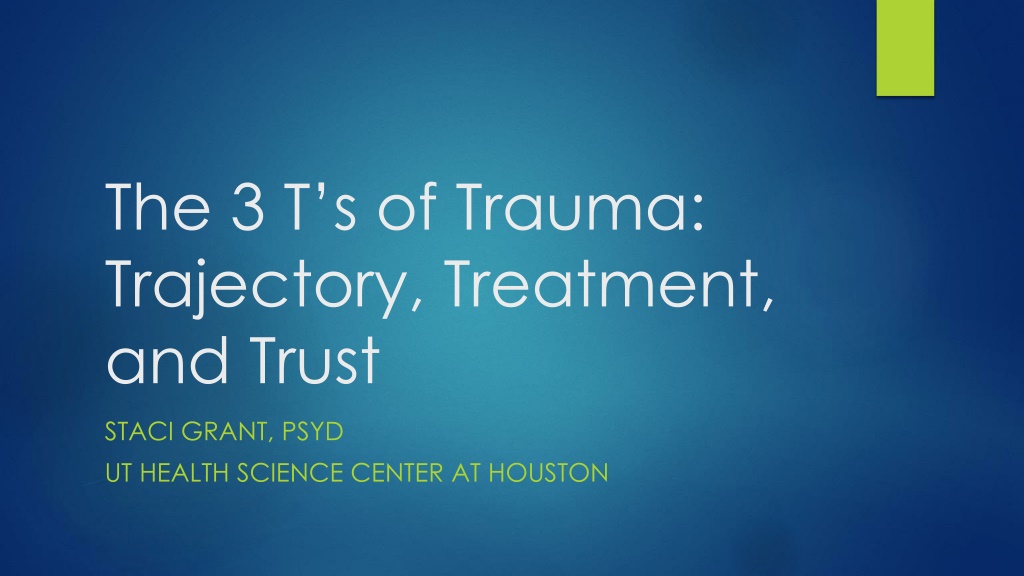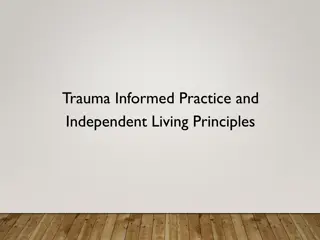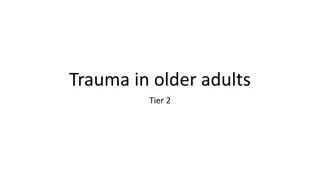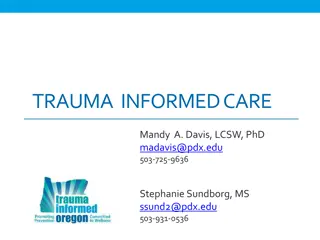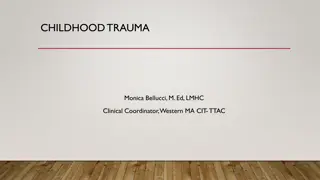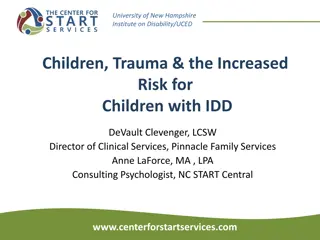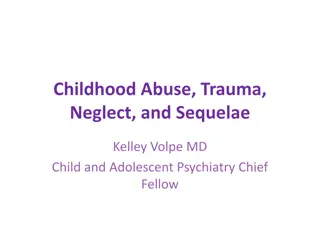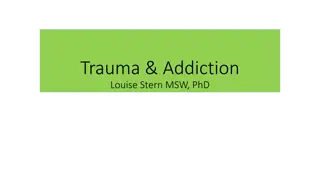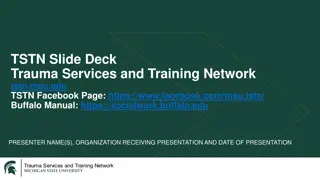Understanding the 3 Ts of Trauma: Trajectory, Treatment, and Trust
This comprehensive guide delves into the critical aspects of trauma - Trajectory, Treatment, and Trust. It covers the definition of trauma, PTSD symptoms, potentially traumatic events, trajectories of traumatic stress, and the impact of trauma on mental health. Explore the effects on behavior, biology, cognition, and social aspects, along with common comorbidities like major depressive disorder and substance use disorders. Gain insights into how trauma can lead to prolonged distress, acute reactions, and resilience.
Download Presentation

Please find below an Image/Link to download the presentation.
The content on the website is provided AS IS for your information and personal use only. It may not be sold, licensed, or shared on other websites without obtaining consent from the author. Download presentation by click this link. If you encounter any issues during the download, it is possible that the publisher has removed the file from their server.
E N D
Presentation Transcript
The 3 Ts of Trauma: Trajectory, Treatment, and Trust STACI GRANT, PSYD UT HEALTH SCIENCE CENTER AT HOUSTON
Overview Definition of Trauma Trajectories of Traumatic Stress Trauma-Focused Treatments
Posttraumatic Stress Disorder (PTSD) Exposure to a traumatic event Re-experiencing (1 or more) Distressing dreams, memories, thoughts, physiological reactivity, intense psychological distress Avoidance (3 of more) Places, people, activities Trauma-related thoughts and feelings Increased arousal (2 or more) Difficulty sleeping, irritability, trouble concentrating, hypervigilance, exaggerated startle Symptom duration for more than 1 month (APA, 2013) Causes clinically significant distress or impairment
Trajectories of Traumatic Stress (Lai, Beaulieu, Ogokeh, Tiwari, Self-Brown, 2016)
Impact of Trauma on Mental Health Prolonged, sustained distress and impairment Acute trauma reactions Resilience
Impact of Trauma on Mental Health Affect Behavior Biology Cognitive Social School
Impact of Trauma on Mental Health Comorbidity: Over 80% of persons with PTSD suffer from other psychiatric disorders. Major Depressive Disorder Alcohol/Substance Use Disorders Panic Disorder Suicidality Functional Impairment: Many also experience marital, occupational, financial, and health problems.
Impact of Trauma on Youth Abuse and victimization in childhood correlated with: Trauma and Stressor-Related disorders PTSD, Acute Stress Disorder Anxiety disorders Social Phobia, Generalized Anxiety Disorder Depressive disorders Substance use/abuse/dependence Delinquency and criminal behavior Violent behavior Peer aggression, dating violence, spouse/partner violence
Trauma Symptoms by Age Early Become more fearful in new situations Strong startle reactions, aggressive outburst, regression in milestones due to trauma reminders Poor development of emotional regulation skills Childhood Intrusive thoughts linked to original threat Shift between withdrawn and aggressive behavior Poor emotion regulation Poorer social adjustment and fewer friends School-Age Embarrassed by responses to trauma reminders Increased risky behavior (e.g., substance use, sexual) Poor school performance and occupational achievement Adolescence
Trauma Symptoms by Age Early Impacts brain development that governs emotion Can effect IQ and use of thinking to regulate emotions Childhood Lessened ability to manage fears, anxieties, and aggression Difficulty with sustaining attention for learning Problems with impulse control School-Age Difficulty appraising danger/safety Poor understanding of consequences of behavior Difficulty with abstract thinking for learning and problem solving Adolescence
PTSD and Young Children Young children can, and do, develop PTSD following trauma exposure Classic triad is apparent Harder to see in preverbal children Greater focus on behavioral observations (more nightmares, traumatic play) DC 0-3: Includes items more developmentally sensitive to the age group (e.g., new separation anxiety, new fears unrelated to trauma, loss of previously acquired skills)
Trauma INFORMED vs Trauma SPECIFIC Trauma Informed services incorporate knowledge about trauma in all aspects of service delivery Police investigations Legal proceedings Child welfare Physical exams Mental health assessment
Trauma INFORMED vs Trauma SPECIFIC Trauma Specific treatments are designed specifically to address trauma-related symptoms, such as: Prolonged Exposure (PE) Cognitive Processing Therapy (CPT) Trauma Focused Cognitive Behavioral Therapy (TF-CBT)
Trauma-Focused Treatments Some of the core components of trauma-focused interventions include: Psychoeducation (trauma and its impact) Directly addressing and processing traumatic experience as well as grief and loss (when appropriate) Increasing individual s sense of physical and psychological safety Identifying triggers for trauma reactions Developing emotional regulation skills (skills to control and express strong feelings) Developing trauma-informed parenting skills Focus is on symptoms improvement AND improving functioning, resiliency and developmental trajectory.
Trauma-Focused Treatments Abuse-Focused Cognitive Behavioral Therapy (AF-CBT) Child-Parent Psychotherapy (CPP) Cognitive Behavioral Intervention for Trauma in Schools (CBITS) Cognitive Processing Therapy (CPT) Eye Movement Desensitization and Reprocessing (EMDR) Multisystemic Therapy (MST)
Trauma-Focused Treatments Parent Child Interaction Therapy (PCIT) Project SafeCare Seeking Safety The Incredible Years (TIY) Series Trauma-Focused Cognitive-Behavioral Therapy (TF-CBT) Triple P Positive Parenting Program
Trauma-Focused Treatments Parent-Child Interaction Therapy (PCIT) Evidence-based approach originally intended to treat disruptive behavior problems in children age 2.5 to 7 years Targets caregiver-child relationship Teaches parents skills to improve their relationship with their children (Child Directed Interaction) Teaches positive parenting and appropriate and safe discipline skills (Parent Directed Interaction) Short-term, but NOT time-limited 12 to 14 sessions on average
Trauma-Focused Treatments Trauma-Focused Cognitive-Behavioral Therapy (TF-CBT) Evidence-based and evidence supported Conjoint child and parent psychotherapy model Effective with children age 3 to 18 years Experiencing significant emotional and behavioral difficulties related to traumatic life events Component-based treatment protocol Time limited, structured approach Usually completed within 12-20 sessions
Trauma-Focused Treatments Very important to Identify trauma reminders AKA Triggers Person, place, thing, situation, internal state, song, smell, etc. Internal or external Recognizing connections between triggers and trauma responses is CRITICAL to effective treatment Provide trust and support!
Where do I find information about EBTs for Trauma? www.nctsn.org http://www.nctsn.org/resources/topics/treatments-that- work/promising-practices https://www.childwelfare.gov/pubs/guide2011/guide.pdf http://www.cebc4cw.org/ (California evidence-based clearinghouse)
Questions? THANK YOU!
References American Psychiatric Association. (2013). Diagnostic and statistical manual of mental disorders (5th ed.). https://doi- org.ezproxy.frederick.edu/10.1176/appi.books.9780890425596 Finkelhor D, Turner H, Ormrod R, Hamby SL. Violence, abuse, and crime exposure in a national sample of children and youth. Pediatrics. 2009 Nov;124(5):1411-23. doi: 10.1542/peds.2009-0467. Epub 2009 Oct 5. PMID: 19805459. Finkelhor, D. Turner, H.A., Shattuck, A., & Hamby, S.L. (2013). Violence, crime, and abuse exposure in a national sample of children and youth: An Update. JAMA Pediatrics, 167(7), 614-621. Lai, B. S., Osborne, M. C., Lee, N., Self-Brown, S., Esnard, A. M., & Kelley, M. L. (2018). Trauma-informed schools: Child disaster exposure, community violence and somatic symptoms. Journal of affective disorders, 238, 586 592. https://doi.org/10.1016/j.jad.2018.05.062
References (Cont.) Scheeringa, M. S., Peebles, C. D., Cook, C. A., & Zeanah, C. H. (2001). Toward establishing procedural, criterion, and discriminant validity for PTSD in early childhood. Journal of the American Academy of Child & Adolescent Psychiatry, 40(1), 52-60. Scheeringa, M. S., & Zeanah, C. H. (1995). Symptom expression and trauma variables in children under 48 months of age. Infant mental health journal, 16(4), 259-270. Scheeringa, M. S., Zeanah, C. H., Drell, M. J., & Larrieu, J. A. (1995). Two approaches to the diagnosis of posttraumatic stress disorder in infancy and early childhood. Journal of the American Academy of Child & Adolescent Psychiatry, 34(2), 191-200.
